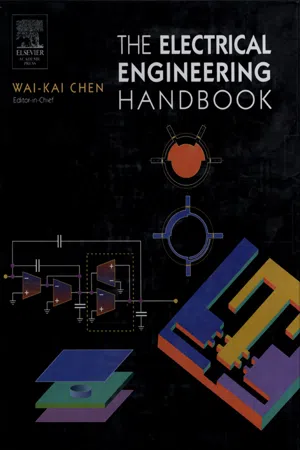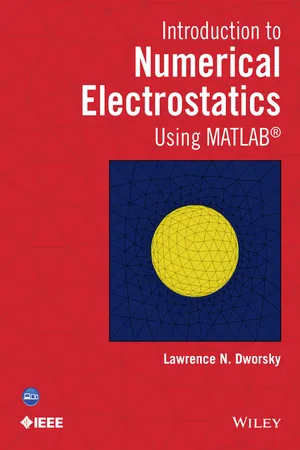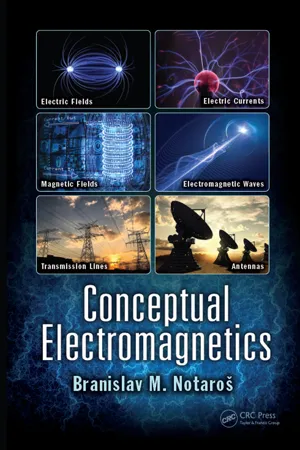Physics
Electrostatics Boundary Conditions
Electrostatics boundary conditions refer to the rules that govern the behavior of electric fields at the boundaries between different materials or regions. These conditions dictate how the electric field and electric potential must behave at the interface between two different mediums, such as conductors and insulators. They are crucial for understanding and solving electrostatics problems involving different materials and interfaces.
Written by Perlego with AI-assistance
Related key terms
Related key terms
1 of 4
Related key terms
1 of 3
7 Key excerpts on "Electrostatics Boundary Conditions"
- eBook - ePub
- Roger E. Harrington(Author)
- 2012(Publication Date)
- Dover Publications(Publisher)
The boundary conditions for a dielectric-to-conductor boundary are then obtained from the general relations by setting E and D in the conductor equal to zero and V equal to a constant. Note that the normal component of D is equal to the surface-charge density on the conductor. These boundary conditions are summarized in Col. III of Table 8-1. The boundary conditions needed to obtain a unique solution have been discussed in Sec. 8-2. There is, however, an additional condition applicable to electrostatics that we have not mentioned. Letting the field C = E and the potential g = V, suppose that part of the boundary surface encloses a conductor. Since the conductor is an equipotential surface, Eq. (8-4) taken over the conductor is of the form where q′ and q″ are the total charges on the conductor for the E′ and E″ fields. This vanishes if q′ = q″. Therefore, a specification of the total charge on conducting bodies is sufficient to ensure uniqueness of the field. This is, of course, in addition to the usual boundary conditions over those surfaces that do not coincide with conductors. Given sufficient boundary conditions, the solution is unique; so any procedure used to obtain this solution is justified. The general procedure is to take known solutions to the field equations, or linear combinations of them, and attempt to satisfy boundary conditions. At this stage of development, our supply of known solutions is somewhat limited, but it is nevertheless sufficient for quite a number of problems. For example, is a known solution which we recognize as being associated with a point charge at the origin. But now we view it merely as a function which satisfies the field equations, regardless of K 1 and K 2. It is these constants (parameters not dependent on the coordinates) that we may adjust to satisfy boundary conditions - eBook - ePub
- Stanley Humphries Jr.(Author)
- 2020(Publication Date)
- CRC Press(Publisher)
Section 2.4 discusses the classes of charge density that arise in electrostatics, emphasizing the charge displacement in dielectric materials.Section 2.5 initiates the discussion of finite-element techniques. The section introduces the computational mesh, where the solution volume is divided into elements. The set of element boundaries looks like a mesh or screen. In two dimensions, the best choice of elements is a set of flexible triangles with sides aligned along the boundaries of electrodes and dielectrics. This choice gives an accurate representation of material discontinuities. The section also discusses the general strategy of numerical solutions and the importance of boundaries. Section 2.6 reviews useful relationships from analytic geometry for triangles. Section 2.7 contains the most important derivation in the book. The section shows how the application of Gauss’ law in Cartesian coordinates over the elements surrounding a vertex yields a simple difference relationship between the potential at the point and its neighbors. The resulting set of coupled linear equations can be solved on a digital computer. Section 2.8 extends the derivation to three-dimensional systems with cylindrical symmetry.2.1 Coulomb’s Law
Electrostatics describes the forces between charged bodies at given positions. We denote the charge on an object, a positive or negative quantity, by the symbol q. Throughout this book, we shall use the International System of Units where the charge is given in units of coulombs. The charge of an electron is –1.60219 × 10-19 coulombs. The empirical relationship for the forces between stationary charges was discovered by Coulomb in 1771. Suppose there are two small objects with charges q1 and q2 . As shown in Figure 2.1 , the unit vectorpoints from object 2 to object 1 and the distance between the charges is r21n ^21 - eBook - ePub
- Wai Kai Chen(Author)
- 2004(Publication Date)
- Academic Press(Publisher)
2Electrostatics
Rodolfo E. Diaz, Department of Electrical Engineering, Ira A. Fulton School of Engineering, Arizona State University, Tempe, Arizona, USA2.1. Introduction2.1.1. Conventions2.2. Sources and Fields2.2.1. D Fields of Charge Distributions Using Gauss’s Law2.2.2. First Alternative to Gauss’s Law: Integration over Charge Distributions 2.2.3. Second Alternative to Gauss’s Law: The Potential Function2.3. Boundary Conditions and Laplace’s Equation2.3.1. The Fields of Charged Conductors and the Method of Images 2.3.2. Laplace’s Equation and Boundary Value Problems2.3.3. The Connection Between D, P, E , and ε2.4. Capacitance2.4.1. Capacitance of Various Configurations and Energy 2.4.2. Partially Filled Capacitors 2.4.3. Static Current FieldsReferences2.1 Introduction
Electrostatics in its most restrictive sense is the specialization of Maxwell’s equations to a system whose sources are steady-state, time-invariant electric charges. Because the conservation of charge is implicit in this definition, the unifying principle of all the equations is the conservation of total electric flux. Therefore, electrostatics also properly includes steady-state conduction current problems.In this chapter, the fundamental relationship between source and field is between the electric charge q (measured in coulombs) and the electric flux density D (measured in coulombs per meter squared) because that relationship has the form of a conservation law. The electric field E (measured in volts per meter) is introduced with the concept of the electrostatic potential Φ (measured in volts) as the quantity involved in the dynamics of electrostatic systems (i.e., their interaction forces and energies). In this way, ε (measured in farads per meter), the permittivity of the material medium through which the flux traverses, appears as a proportionality constant that gauges the amount of energy stored in a given electrostatic system. Capacitance C (measured in farads) is then a purely geometric expression of the arrangement of that energy inside the system. The concepts of electrostatics are extended to the case of current flow in resistive environments by the recognition of the formal analogy between the electrostatic flux and the current density flux J (in amperes per meter2 - eBook - ePub
- Louis Brand(Author)
- 2012(Publication Date)
- Dover Publications(Publisher)
a . We thus obtainEquating these values when r = a , we find C = 3q /8πεα ; hence83. Conductors. In a conductor interior charges move rapidly to its surface (§76 ). Consequently a conductor in electrostatic equilibrium has only surface charges. Thus, if a charge q is placed inside an isolated conductor K , the charge will distribute itself over the surface with adensity ω so that .In the interior of a conductor J = 0 andand, since E = −∇φ ,Moreover φ has this same constant value at the surface of the conductor by reason of its continuity (§82 ); henceThe boundary of a conductor is an equipotential surface .If a conductor K 1 is surrounded by a dielectric medium 2 of permittivity ε , the boundary conditions (82.19 –20 ) take the formwhere n is a unit normal external to K . In terms of potential, these becomehence at the surface of a conductor the potential satisfies the boundary conditionsA fundamental problem in electrostatics may be formulated as follows. A number of finite conductors bounded by surfacesKiare placed in a dielectric of constant permittivity ε which is free from charges. If eachKiis given a chargeqi, together they produce an electrostatic field whose potential φ satisfies Laplace’s equationin the uncharged (p = 0) dielectric. On the surface of each conductorKi, φ satisfies the boundary conditionswhere the constantsφiare in general unknown. We then seek a solution of Laplace’s equation which satisfies the boundary conditions and is regular at infinity. If this problem has a solution it is unique .Proof If φ 1 and φ 2 are solutions, ψ = φ 1 −φ 2 satisfies ∇2 ψ = 0 with the boundary conditions on each K i :For any function ψ regular at infinity we may apply the divergence theorem to ψ ∇ψ in the infinite regionwe then obtainV∞outside of the conductors; sincefrom the boundary conditions (8 –9 ); as to the minus sign, note that the normals external to V ∞ are internal to the conductors. Since E = −∇φ is everywhere continuous in the dielectric, |∇ψ | is continuous and the volume integral cannot vanish unless ∇ψ = 0. Hence ψ = const, and the constant is zero owing to the regularity of ψ at infinity; thus φ 1 = φ 2 - Lawrence N. Dworsky(Author)
- 2014(Publication Date)
- Wiley-IEEE Press(Publisher)
1 A Review of Basic ElectrostaticsElectric and magnetic phenomena, including electromagnetic wave propagation, are described by Maxwell’s equations.1 When nothing is changing with time, that is, when all derivatives with respect to time are zero, the electric and the magnetic phenomena decouple and become separate electric and magnetic phenomena. These are referred to respectively as electrostatics, which describes the properties of systems with separated static regions of positive and negative electric charge (although the entire system is charge-neutral), and magnetostatics, which describes the properties of systems with electric currents and/or magnetized materials.In this book we shall consider only electrostatics. This subset of a subset of topics describes a vast number of real-world situations. Chapter 2 describes some practical needs and uses of electrostatic analyses, the remainder of the book will be dedicated to examining several techniques for performing these analyses.The materials to follow are intended to be a quick review of the relationships that will be used throughout this book. The intent here is to provide a consistent set of notation using all the relationships that will be needed going forward. Many of these relationships are stated without derivation or proof. A more complete electrostatics theory text is recommended for newcomers to the subject. There are very many excellent texts available. The references list at the end of this chapter is certainly not exhaustive, but the texts cited are considered standards in the field.1.1 Charge, Force, and the Electric Field
Electric charges exert forces on one another. This is the basis of electrostatics. The characteristics of these forces are summarized in Coulomb’s law:- Electric charge carries a polarity, or sign. The choice of sign was originally arbitrary, but now is established by tradition—the electron, the most common charged subatomic particle, carries a negative charge.
- eBook - ePub
- Anupam Garg(Author)
- 2012(Publication Date)
- Princeton University Press(Publisher)
2 In sec. 91 we discuss the variational method, which is even less systematic, but which can provide quick approximate answers. Finally, in section 92, we discuss the numerical relaxation method.The reader should not infer from the above comments and the title of this chapter that the electrostatics inside conductors is unworthy of study. Nonzero static electric fields can arise inside a conductor in the vicinity of impurity ions with a different valence than the host metal (Al in Cu, e.g.), and near metal surfaces. While it is true that in these two examples, the fields are limited to spatial regions of atomic dimensions, they can still have macroscopic manifestations. If two unlike metals are in contact, e.g., then there is a potential difference between them, known as the contact potential , of the order of 1 V. This potential gives rise to a macroscopic electric field outside them and can be measured with macroscopic instruments. We discuss such effects in section 93.86 Electric fields inside conductors, and at conductor surfaces
The macroscopic Maxwell equations that determine the electric field are eqs. (81.9) and (81.16). In electrostatics we are concerned only with the fields produced by static charges. In particular, there are no steady currents, which would give rise to magnetic fields. For most metals, B = 0 inside the conductor, and so B = 0 everywhere. For ferromagnetic metals, such as iron and nickel, B ≠ 0 in the interior, and then because of the remaining Maxwell equations, B ≠ 0 in the exterior either.3 For statics, however, B - eBook - ePub
- Branislav M. Notaroš(Author)
- 2017(Publication Date)
- CRC Press(Publisher)
ELECTROSTATIC FIELD IN DIELECTRICS IntroductionDielectrics or insulators are nonconducting materials, having very little free charges inside them (theoretically, perfect dielectrics have no free charges). However, another type of charge, called bound or polarization charges, exist in a polarized dielectric, as atoms and molecules in the dielectric behave like microscopic electric dipoles. In electrostatic systems containing both conductors and dielectrics, the equivalent electric-field sources are both free and bound charges, considered to reside in free space. By introducing the concept of dielectric permittivity, we are left, in turn, to deal with free charges in the system only, while the contribution of bound charges to the field is properly added through the permittivity. In continuation, we analyze capacitors and transmission lines, composed of both conductors and dielectrics, to evaluate and discuss their capacitance, energy, and breakdown characteristics, as a culmination of our study of the theory and applications of the electrostatic field.2.1 Polarization of DielectricsEach atom or molecule in a dielectric is electrically neutral. For most dielectrics, centers of “gravity” of the positive and negative charges in an atom or molecule coincide – in the absence of the external electric field. When a dielectric is placed in an external field, of intensity E, however, the positive and negative charges shift in opposite directions against their mutual attraction, and produce a small electric dipole. The moment of this equivalent dipole is given by p = Qd, where Q is the positive charge of the atom or molecule (−Q is the negative charge), and d is the vector displacement of Q with respect to −Q. The charges are displaced from their equilibrium positions by forces [Eq. (1.3) ] Fe1 = QE and Fe2 = −QE, respectively. The displacement d is very small, on the order of the dimensions of atoms and molecules. The charges Q and −Q are bound in place by atomic and molecular forces and can only shift positions slightly in response to the external field. So, the two charges in an equivalent small dipole cannot separate one from the other and migrate across the material in opposite directions run by the electric field. Hence, these charges are called bound charges (in contrast to free charges). Some dielectrics, such as water, have molecules with a permanent displacement between the centers of the positive and negative charge, so that they act as small electric dipoles even with no applied electric field. According to Figure 2.1 , the torques (moments) of forces Fe1 and Fe2 with respect to the center of the dipole (point O) are T1 = r1 × Fe1 and T2 = r2 × Fe2 , with r1 and r2 denoting the position vectors of Q and −Q with respect to the dipole center. We notice that r1 − r2 = d
Index pages curate the most relevant extracts from our library of academic textbooks. They’ve been created using an in-house natural language model (NLM), each adding context and meaning to key research topics.
Explore more topic indexes
Explore more topic indexes
1 of 6
Explore more topic indexes
1 of 4






